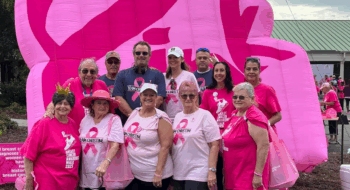Oncoplastic surgery is a modern surgical approach that combines breast cancer removal with cosmetic breast reconstruction, often in a single procedure. The technique allows women to prioritize health while preserving the natural appearance of their breasts.
“You’re treating cancer — that’s the ‘onco’ part — and still providing a good cosmetic outcome, which is the ‘plastic’ part,” says Dr. Angela Stork, a breast surgeon at the Tidelands Health Breast Center.
Tidelands Health is accredited by the National Accreditation Program for Breast Centers and Tidelands Health Cancer Care Network is a member of the MUSC Hollings Cancer Network, South Carolina’s only National Cancer Institute-designated cancer center.
How oncoplastic surgery works
Oncoplastic surgery merges oncologic and plastic techniques. It has evolved significantly over the past decade, offering women more options and better outcomes than ever before.
In the past, breast cancer surgery often left women with visible scars or disfigurement. Today, that’s become less and less common.
“We’re learning that doesn’t have to be the case — that women can be treated for their cancer and still be happy with the cosmetic appearance, as well,” Dr. Stork says.
Types of oncoplastic techniques
Just as there are many types of breast cancer, there are many different techniques in oncoplastic surgery.
There’s no one-size-fits-all approach. Oncoplastic surgery is tailored to each patient’s diagnosis and preferences. Techniques may include:
- Incisions made in a less visible place during a lumpectomy
- Tissue rearrangement to fill cavities left by tumor removal
- Flat closure for women who choose not to have reconstruction after mastectomy
- Symmetry procedures on the opposite breast to ensure a balanced appearance
Although removing cancer is the priority, patients deserve to have good cosmetic outcomes, as well, Dr. Stork says. She encourages patients to talk to their surgeons about what their breasts may look like after surgery and ask questions about the different surgical options.
“For the most part, patients are pretty surprised to hear about these options,” Dr. Stork says. “I think patients have heard or seen pictures or they know people with disfigured breasts. They’re very happy to learn that they don’t have to have a significant defect or their breast may look pretty normal or natural afterward.”

Dr. Angela Stork
Breast surgeon at Tidelands Health Breast Center
Bio
Dr. Angela Stork sees patients at Tidelands Health Breast Center locations in Myrtle Beach, Murrells Inlet and Georgetown.
Dr. Stork is certified by the American Board of Surgery and is a fellow of the American College of Surgeons. She earned her medical degree from the University of Iowa Carver College of Medicine and completed a residency in general surgery at the University of Iowa Hospitals and Clinics.
Learn MoreMedical Education
Education
University of Iowa, Carver College of Medicine
Residency
University of Iowa, Hospitals and Clinics
Awards
Board Certifications:
- Fellow, American College of Surgeons
- Board Certified, American Board of Surgery
Meet the Expert
Dr. Angela Stork
Dr. Angela Stork sees patients at Tidelands Health Breast Center locations in Myrtle Beach, Murrells Inlet and Georgetown.
Dr. Stork is certified by the American Board of Surgery and is a fellow of the American College of Surgeons. She earned her medical degree from the University of Iowa Carver College of Medicine and completed a residency in general surgery at the University of Iowa Hospitals and Clinics.






